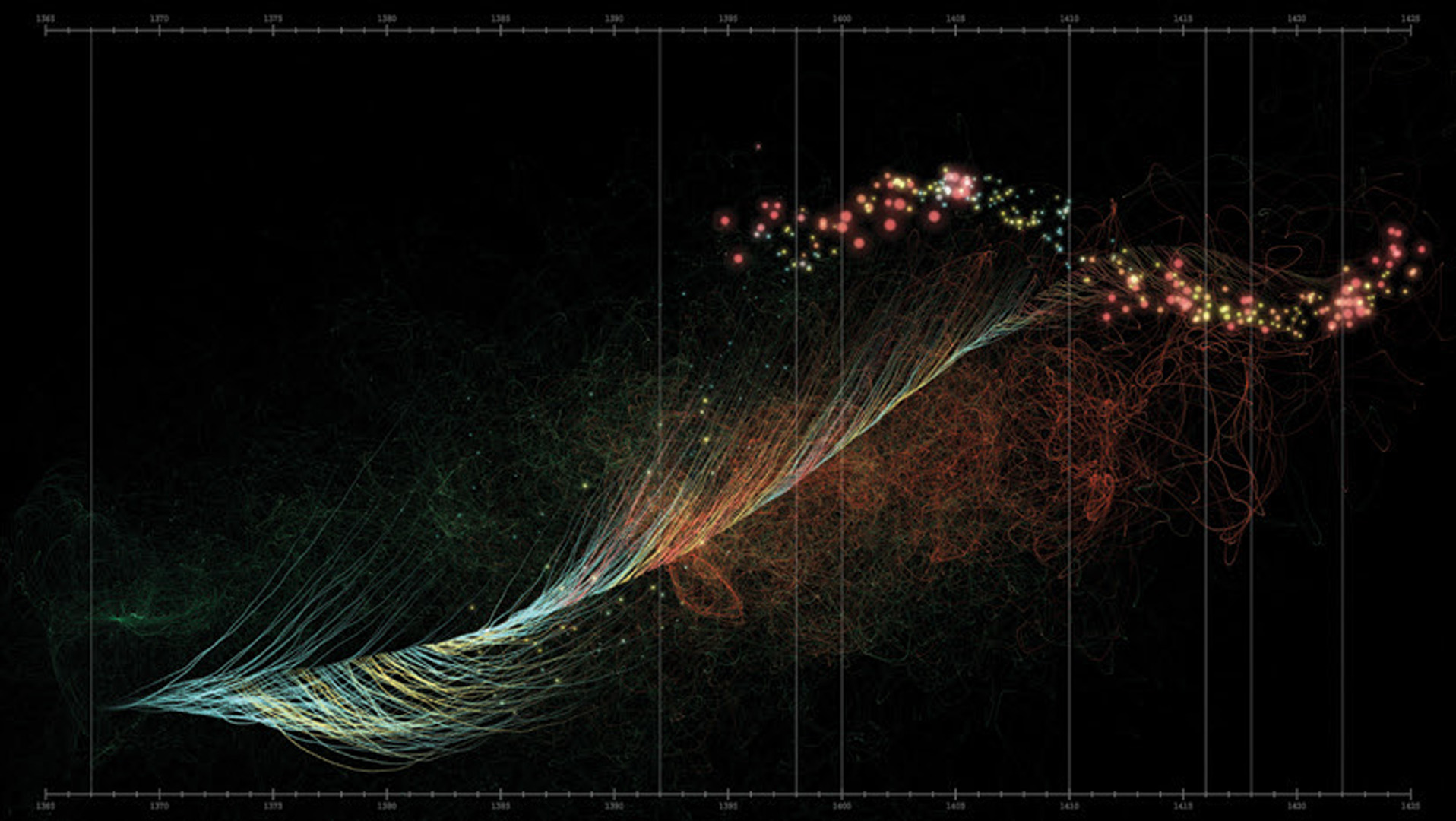“Visual History with Choson Dynasty Annals” by Park, Lee and Park
Conference:
Type(s):
Title:
- Visual History with Choson Dynasty Annals
Presenter(s)/Author(s):
Abstract:
For this paper, the authors selected three historical events taken from the Annals of the Choson Dynasty that represent dramatic and tragic stories about parents and their sons for data visualization. By connecting names with entities indicating conductions from history books, they found interesting patterns that tell stories with embedded relations. The visualized images in this paper were mainly code-generated, based on the data of the Annals, with some graphic embellishment added.
References:
1. J.W. Park, Visual Genealogy, ACM SIGGRAPH 2007 Art Gallery, San Diego, California, 2007; J.W. Park, Visual Genealogy: MR. Park, Myrang-Hwarok Clan, ACM SIGGRAPH 2009 Information Aesthetics, New Orleans, Louisiana, 2009.
2. J.W. Park, “Information Aesthetics with Visual Genealogy Project,” Leonardo Vol. 44, No. 5, 464–465 (2011).
3. Unlike static historical data, contemporary data grows and becomes big data, which makes it hard to mine and analyze. A good example of computer-based visual analysis for contemporary data is Lev Manovich’s cultural analytics, which covers films, animations, video games, comics, magazines, books and other media. <http://lab.softwarestudies.com/p/cultural-analytics.html>.
4. Carr argues that viewing history as accurate (and independent of human opinion) is improper, because historians selectively choose facts based on particular interests. E.H. Carr, What is history?, 3rd Revised ed. (Basingstoke, UK: Palgrave Macmillan, 2002). Hayden White also points to the problem of historical representation, which recounts not merely a neutral real event, but entails an ontological and epistemic choice with distinct ideological and even specific political implications. H. White, The Content of the Form: Narrative Discourse and Historical Representation (Baltimore: Johns Hopkins University Press, 1990).
5. In 1870, Francesco Datini’s business records were found in Prato. These private records provide insight into the medieval-renascent merchant class in the 14th and 15th centuries.
6. Historical facts recorded by day, month, and year, which is the most common and traditional way of recording history in Eastern Asia.
7. The Annals was listed in UNESCO’s Memory of the World Register, and despite the existence of other annals around the world, this is the first and only case of annals being listed.
8. Annals of Taejong, fourth year (1404), February 8th, fourth article. “After the king fell from a horse, he looked left and right, and he asked, ‘Do not let historiographers know this.’”
9. A similar structure can be found in “Saga” or in the epic novel. A. Cappelli et al., “The Social Network of Dante’s Inferno,” Leonardo Vol. 44, No. 3, 246–247 (June 2011).
10. The Annals of the Joseon Dynasty, <http://sillok.history.go.kr/main/main.do>.
11. From the movie Star Wars: The Force Awakens (2015): “Nothing will stand in our way. I will finish what you started.” The father and son relationship is the same in this epic contemporary fictional saga as the one recorded in the Annals.
12. J. Brown and J. Brown, China, Japan, Korea: Culture and Customs (Seattle: Book Surge Publishing, 2006).
13. “Taejong” is Bang Won Yi’s posthumous royal name.
14. H. Park, “King Taejong as Statesman: From Power to Authority,” Korea Journal, 207 (Winter 2006).
15. M. Waller, Sovereign Ladies: The Six Reigning Queens of England (New York: St. Martin’s Press, 2006) 116.
16. A. Whitelock, Mary Tudor: England’s First Queen (London: Bloomsbury, 2009).
17. On executing people whose cardinal sins are exposed after death: Records show that Oliver Cromwell of England was also sentenced to a posthumous execution by Charles II. R.L. Bradshaw, God’s Battleaxe (Bloomington, IN: Xlibris, 2010) 379–381.
18. Although the king’s revenge was the only motive that had been recognized, the political confrontation between the two parties of courtiers might also be a plausible reason. His opponents used the king’s fury to gain political leverage.
19. Quotation from the movie Sado (2015), directed by Joon-ik Lee.
20. Yeongjo created a policy with the intention of adjusting the balance between political parties to prevent conflicts.




